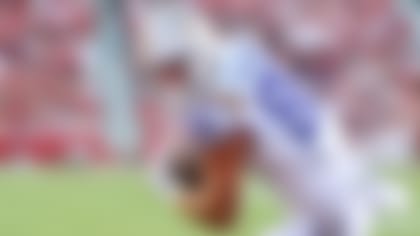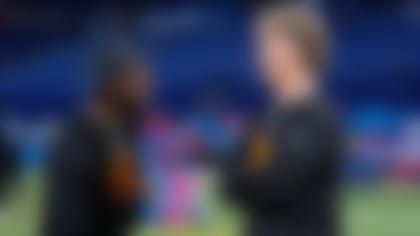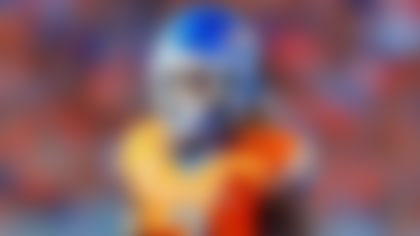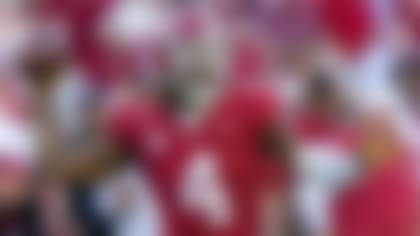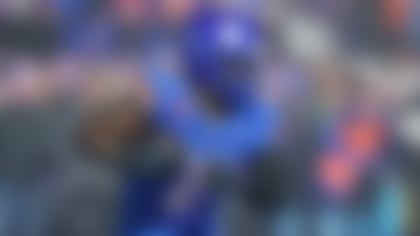It happens every fall. A player bursts onto the scene, makes a big play or helps his team win a pivotal game, and the collective football world celebrates his arrival as a true difference maker in the NFL. Let's get ahead of the curve! In advance of the 2013 season, NFL.com analyst Bucky Brooks identifies candidates for significant improvement, concentrating on wide receivers below. **Click here for other positions.**
Most Improved Wide Receiver for 2013: Michael Floyd
Rapoport: Bruce to the rescue?

Floyd's backstory: The Arizona Cardinals selected Floyd with the 13th overall pick in the 2012 NFL Draft to serve as a legitimate complementary receiver to Larry Fitzgerald. However, Floyd failed to win the No. 2 job in training camp and played sparingly until the end of his rookie season. When he hit the field, Floyd showed flashes of immense potential, but inconsistency separating from defenders and occasional mental miscues prevented him from taking on a bigger role in the game plan.
Of course, Arizona's revolving door at quarterback didn't help Floyd's maturation process. Kevin Kolb, John Skelton, Ryan Lindley and Brian Hoyer struggled to get the ball to receivers on the perimeter. Consequently, Floyd rarely got a chance to build on some of the splash plays that he produced throughout the season.
Why he will improve in 2013: First-year head coach Bruce Arians is ushering in a new era with a dynamic aerial attack directed by new quarterback Carson Palmer. While the system places an emphasis on pushing the ball down the field, Arians will utilize a myriad of simple concepts designed to create easy throws for the QB. From tradition three- and four-vertical routes to a variety of "Dino" concepts (double-post routes), Arians cleverly crafts passing plays to stretch the defense vertically, while also creating good opportunities for his playmakers against isolated coverage. As a result, his receivers pile up receptions of 20-plus yards, boosting yards-per-catch averages over the 15.0 mark, which is the standard for big-play wideouts in the NFL.
For Floyd, the shift to a vertical passing game will accentuate his strengths as a big-bodied receiver with strong hands. He excels at shielding defenders away from the ball and high-pointing passes in traffic. Given those traits, Palmer should throw plenty of passes in Floyd's direction to take advantage of his huge catch radius. The video clip to your right, from Floyd's brilliant Week 17 outing against the San Francisco 49ers (eight catches for 166 yards and a touchdown), illustrates how the receiver uses his size and strength to come down with 50-50 balls.
The move to a downfield passing attack also will help Floyd become a better route runner in his second season. Big receivers typically struggle executing routes that feature stop-start elements due to the challenge of regenerating speed out of the break. As a result, they fail to create space or run away from defenders, despite possessing superior talent. This isn't a problem in a vertical scheme because most of the routes keep receivers on the move. Breaking down Floyd's Notre Dame tape prior to the 2012 draft, I believed he was at his best when featured on vertical routes. He had a knack for getting behind defenders, despite lacking sub-4.5 speed. Floyd continued to display those traits a season ago, when the Cardinals would attempt to get him the ball on go-routes or fade-routes down the boundary, like in the video to your right just below.
Given Palmer's strengths as a deep-ball thrower, Floyd should produce plenty of fireworks for the Cardinals in 2013.
Impact on the team: The Cardinals' offense has been lacking an explosive 1-2 punch at receiver since Anquan Boldin was traded to the Baltimore Ravens following the 2009 season (when the franchise made its last playoff appearance). With Floyd set to fill the role of trusty sidekick to Fitzgerald, the Cardinals could make a run at a winning season behind a rejuvenated offense.
Projected 2013 stat line: 75 receptions, 1,150 yards and eight touchdowns.
Other Wide Receivers to Watch
Alshon Jeffery, Chicago Bears: The big-bodied playmaker suffered through an injury-plagued rookie season, but Bears fans should be optimistic about his chances to develop into a key playmaker based on his spectacular flashes in 2012. Of Jeffery's 24 catches, six covered at least 20 yards, with two going beyond 40. These explosive plays showcased a unique combination of size, strength and ball skills. With Brandon Marshall as the object of the defense's attention, Jay Cutler could direct more throws in Jeffery's direction, taking advantage of single coverage on the backside.
Rueben Randle, New York Giants: The Giants might've uncovered a hidden gem in the 2012 draft with the last pick of the second round. Randle displays a polished game built on precise route running and superb ball skills. Most importantly, Randle has developed a rapport with Eli Manning that should translate into improved numbers for the Giants' No. 3 receiver. Factor in the impending free agency of Victor Cruz and Hakeem Nicks, and Big Blue could use the 2013 season to groom Randle for a starting role in the very near future.
Austin Pettis, St. Louis Rams: The additions of Tavon Austin and Stedman Bailey were designed to help Sam Bradford realize his potential as a franchise quarterback, but it's the emergence of Pettis as a key playmaker that could accelerate the fourth-year signal-caller's growth. Pettis totaled 16 receptions over the final five games of 2012, showing the versatility to work from the slot or outside. He has continued to develop throughout the offseason, leading some to tout him as the MVP of Rams OTAs/minicamp. With St. Louis' offense in desperate need of a No. 1 receiver, Pettis' size, versatility and red-zone prowess (four touchdowns in 2012) could make him a major factor in the Rams' game plan this fall.
Follow Bucky Brooks on Twitter @BuckyBrooks.


